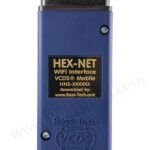The Audi A4, like many modern vehicles, utilizes a sensor to monitor the washer fluid level and alert the driver when it’s low. This sensor, often accessed and diagnosed using VCDS (VAG-COM Diagnostic System), can sometimes malfunction, leading to inaccurate readings or a persistent low-fluid warning. This article will delve into troubleshooting common issues related to the Vcds Washer Fluid Level sensor in an Audi A4.
Understanding the Washer Fluid Level Sensor System
The washer fluid level sensor, typically a float-activated switch (G33), resides within the washer fluid reservoir. It communicates with the vehicle’s onboard computer system (BCM/Cluster – J519) via a dedicated wiring circuit. When the fluid level drops below a certain threshold, the sensor triggers a signal, illuminating a warning light on the dashboard. VCDS allows access to specific data blocks within these modules, enabling technicians to monitor sensor readings and diagnose faults. As illustrated in the provided wiring diagrams, the sensor’s circuit shares connections with other components (F34, G17, G32), potentially complicating diagnostics.
Common VCDS Washer Fluid Level Sensor Problems
Several issues can arise with the washer fluid level sensor:
- Faulty Sensor: The sensor itself may malfunction due to corrosion, damage, or internal component failure.
- Wiring Issues: Damaged or corroded wiring within the sensor circuit can disrupt communication between the sensor and the control module. Shared wiring with other components introduces further points of potential failure.
- Foreign Object Debris (FOD): Debris within the washer fluid reservoir can interfere with the float’s movement, leading to inaccurate readings.
- Software Glitches: Occasionally, errors within the vehicle’s software can cause the system to misinterpret sensor data.
Diagnosing VCDS Washer Fluid Level Sensor Problems using VCDS
Using VCDS, technicians can perform several diagnostic steps:
- Scan for Fault Codes: Initiate a scan of the BCM/Cluster modules using VCDS to identify any stored Diagnostic Trouble Codes (DTCs) related to the washer fluid level sensor.
- Monitor Live Data: Access the relevant data blocks within the BCM/Cluster using VCDS to observe real-time sensor readings. This allows observation of the sensor’s response to fluid level changes.
- Component Testing: Utilize VCDS to activate individual components within the system (e.g., the washer pump) to assess their functionality and isolate potential issues. As suggested, testing voltage at the sensor’s connector (PIN 1 of G33) is crucial. Comparing voltage to shared feed tracks can identify wiring faults.
- Circuit Testing: Inspecting the wiring harness for damage, and performing continuity tests using a multimeter, can pinpoint breaks or shorts in the circuit. The suggested method of using a decade box to simulate resistance values at the control module connector (T32b PINS 28 and 25) can help determine if the control module (J519) is functioning correctly.
Conclusion
Troubleshooting VCDS washer fluid level sensor problems requires a systematic approach involving visual inspection, diagnostic software (VCDS), and potentially some basic electrical testing. By carefully examining the sensor, its wiring, and associated components, along with utilizing the diagnostic capabilities of VCDS, it is possible to accurately pinpoint the root cause of the issue and implement the appropriate solution. Remember to consult your vehicle’s wiring diagrams for accurate pin locations and component identification.

